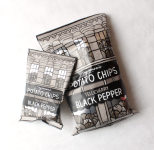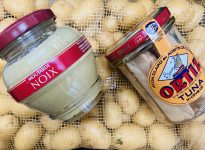Professions of an Anchovy Lover
Ari on Anchovies, Part 1 of 3
 The food world today is filled with some seriously glamorous subjects; for openers, Bacon, of course, is as big it gets. Balsamic vinegar (the real stuff of course), bean to bar varietal chocolate, extra virgin olive oil, farmhouse cheese, sustainably grown produce, and grass-fed beef are all high on “What’s Hot” lists. Lest I forget, everyone (for good reason) loves local. And seasonal, (as it should be), is the shit.
The food world today is filled with some seriously glamorous subjects; for openers, Bacon, of course, is as big it gets. Balsamic vinegar (the real stuff of course), bean to bar varietal chocolate, extra virgin olive oil, farmhouse cheese, sustainably grown produce, and grass-fed beef are all high on “What’s Hot” lists. Lest I forget, everyone (for good reason) loves local. And seasonal, (as it should be), is the shit.
On the other hand there are anchovies. I personally love eating them, but unlike all these others, anchovies are anything but universally loved. In fact, they’re often actually hated. Getting anchovy lovers and haters to a shared understanding is not likely to happen in my lifetime, and I feel bad about it. Because of their bad rap and the profusion of subpar product in the market place, anchovies have been unfairly maligned and inappropriately excluded from far too many people’s every day eating. Sadly the anchovy’s wonderful flavor and culinary complexity is lost to the average, disinterested observer. One experience with bad anchovies sets the stereotype in emotional cement—”I knew I wasn’t going to like these!” and “Sure enough, they suck” are comments that are all too common. Mostly anchovies are assigned blame, nearly always unfairly, for ruining what their detractors are sure would otherwise have been a good meal.
I’m ready to work to open people’s minds, to prove anchovies’ worth to those who long ago wrote them completely out of what’s possible in their cooking. While there are of course, some bad anchovies out there, there is also a wide range of really good ones that often go unnoticed. Anchovies, like people, are a complex lot, with a deep diversity of flavors and wide range differences from one end of the quality spectrum to the other. But one isolated bad anchovy served on a low -end salad bar backs up the stereotype people have heard for so long—millions of men and women reject anchovies without ever really getting to know them.
At least I know I’m not alone in my assessment of the situation. My friend Tamar Adler, whose writing makes me both think and smile at the same time, says in her very excellent book, The Everlasting Meal, that, “Anchovies divide us into lovers and fighters. No one is neutral. The little fish,” she explains, “elicit wistful gazes from their adorers—if you love them you wonder when you will get your next one—and shudders from objectors, far more numerous, who can’t fathom the injustice of ever having to see one of the nasty things again.”
I, like Tamar, take issue with the indignation so many, other- wise upstanding, food-centric citizens direct at the little fish I love so dearly. I love anchovies. I don’t mean “like.” My affection for anchovies is much bigger than that. They’re a big part of my life—I live with them. I eat them and cook with them regularly. I dedicate many a meal to them and they’re often the highlight of my evening’s eating. Because of which, I’m glad to take on the challenge of at least opening, if not ultimately changing, a few minds. As Tamar tells it, anchovies “ . . . are not all universally loved, but few powerful things are.” Rather than fighting that power, both Tamar and I would argue, the idea is to embrace it. Anchovies can help you achieve some pretty amazing things in the kitchen, and are one of the easiest ways I know to make full flavored traditional healthy food in a matter of a few minutes.




Zingerman’s Art for Sale